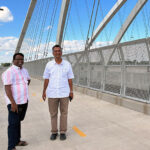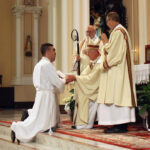
By Lindsay Steele
The Catholic Messenger
(Editor’s note: National NFP Week is held annually near the anniversary of the release of Humanae Vitae (July 25). This year’s theme emphasizes the call to the Joy of Love. For more information go to https://www. usccb.org/topics/natural-family-planning/national-nfp-awareness-week)
One of the greatest benefits of Natural Family Planning (NFP) is the shared responsibility between spouses, says instructor Beth Budelier.
“Most contraceptives rely on the woman to fill the prescription, take the pill, etc.,” said Budelier, a member of St. Paul the Apostle Parish in Davenport. “NFP encourages the husband and wife to be a team and make the decisions of family planning together. We pray about our fertility and discern what is best for our family.”
Budelier, 41, and her husband Al, 52, are parents to five daughters, ages 4-14.
NFP is the only method of family planning approved by the church. Older, calendar-based methods of NFP gained a negative reputation for being unreliable, as they did not take into account the variances in a woman’s cycle. However, modern fertility awareness-based methods involve daily observations of the scientifically verified, natural and recurring signs of fertility and infertility that a woman’s body displays during her monthly cycle. They are 99% accurate in identifying times of fertility and infertility, according to the European Society for Human Reproduction and Embryology.
Using this information, “a couple prayerfully discerns if they feel called to achieve or postpone pregnancy,” said Marianne Agnoli, diocesan Family and Marriage Life Coordinator. She practices and teaches the Billings Method of NFP, which relies on observing physical signs of fertility.
The Budeliers practice and teach a sympto-thermal method of NFP through Couple to Couple League. This method involves crosschecking physical observations with temperature readings. NFP has allowed the Budeliers to space their children and to conceive within one or two cycles when they hope to achieve pregnancy.
NFP requires periods of abstinence and while this isn’t always easy, being mutually committed to NFP helps, Beth said. “We were in agreement that we weren’t going to use artificial contraception or barrier methods early in our relationship, so any frustrations we had with learning the method early on were just hurdles we knew we would be able to overcome.”
She encourages couples to be patient when learning to use NFP. It can take about six cycles for a woman to gain confidence in a method and become familiar with her cycles.
About half the couples Beth and Al work with are engaged. Others have been married several years and decided to learn NFP for a myriad of reasons. Some couples choose not to postpone pregnancy early in their marriage but change their minds due to illness or other life changes, she said. Others were not aware of or receptive to Church teaching on family planning at the time they were married.
Instructors Jessica and Nick Ragsdale, members of Our Lady of Lourdes Parish in Bettendorf, did not begin their NFP journey until after the birth of their oldest child, Sammy. “I realized just how much I had been letting God live on the sidelines of my life,” she said. “Having Sammy definitely helped my heart to grow bigger,” said Jessica, 37.
At her postpartum appointment, she declined when the doctor asked if she’d like to use birth control, but was disappointed and frustrated with herself for not knowing her beliefs well enough to explain them. “I felt like I had just been pegged as an irresponsible parent for not taking the doctor’s birth control prescription,” she recalled. Jessica and Nick became inspired to learn about NFP after reading Pope Paul VI’s encyclical, Humanae Vitae. Nick, 41, initially worried NFP would be ineffective or too complicated, “but he got on board when he learned that NFP can be very, very effective and way, way, way easier to understand than fantasy football.” They follow and teach the sympto-thermal method of NFP through Couple to Couple League.
NFP helped the couple to space and conceive their four children. Sammy is now 8 and their youngest child, Mary Joanna, was born earlier this month. Jessica and Nick are also foster parents.
Agnoli said it is “easier than ever” to receive instruction in most NFP methods through live online instruction or in person with local instructors. The diocesan NFP website, https://www.davenportdiocese.org/natural-family-planning has a link to these resources.
The diocese offers a free Introduction to NFP live virtual instruction each month for anyone interested in learning about NFP. All couples preparing for marriage in the diocese participate in an introductory or method-specific instruction. Anyone with questions may contact Agnoli at agnolim@davenportdiocese.org.
Types of NFP methods
Each of the following NFP methods focus on one or more signs of female fertility:
Cervical Mucus Methods (CMM)
These methods, which observe cervical mucus, are known as the “Ovulation Method” or “OM.” In NFP education, a woman learns how to identify the normal, healthy, cervical mucus that indicates the days that sexual intercourse is most likely to result in pregnancy. A number of NFP providers teach a variety of approaches using this method, for example, Billings Ovulation Method Association — USA, Creighton Model FertilityCare™ Centers and Family of the Americas.
Sympto-Thermal Methods (STM)
These methods, which observe several signs of fertility and crosscheck two or more of the signs to pinpoint ovulation, are known as the “Sympto-Thermal Method” or “STM.” STM typically combines charting the Basal Body Temperature (BBT) and cervical mucus with other optional indicators, such as changes in the cervix and secondary fertility signs. NFP providers teaching these approaches include Couple to Couple League and Northwest Family Services.
Sympto-Hormonal Method (SHM)
This method, which observes several signs of fertility and adds the use of an ovulation predictor kit (OPK) or fertility monitor, is known as the “Sympto-Hormonal Method” or “SHM.” Similar to STM, this approach adds the self-detection of reproductive hormones in the urine with the assistance of an OPK or fertility monitor. Various diocesan NFP programs utilize SHM as well as Marquette University’s Institute for NFP (Marquette Model).
Source: usccb.org











